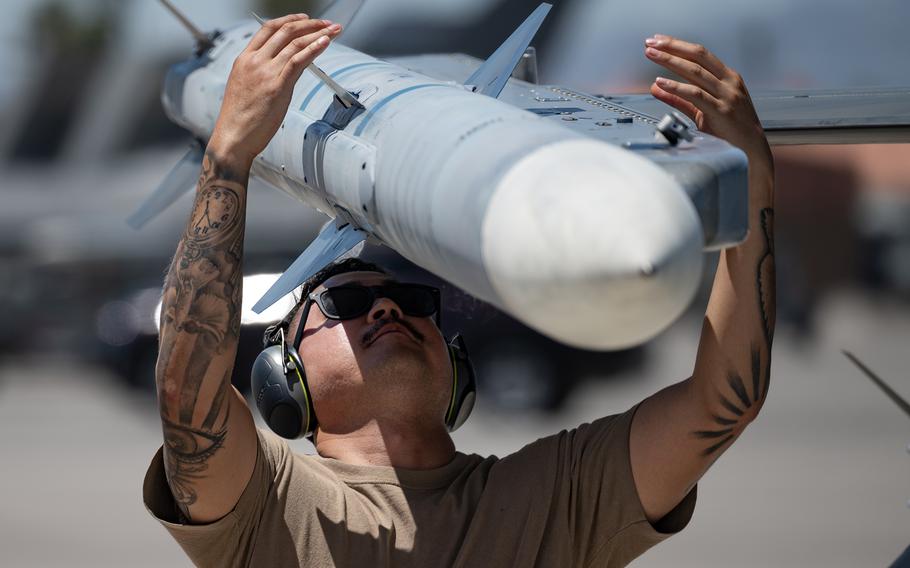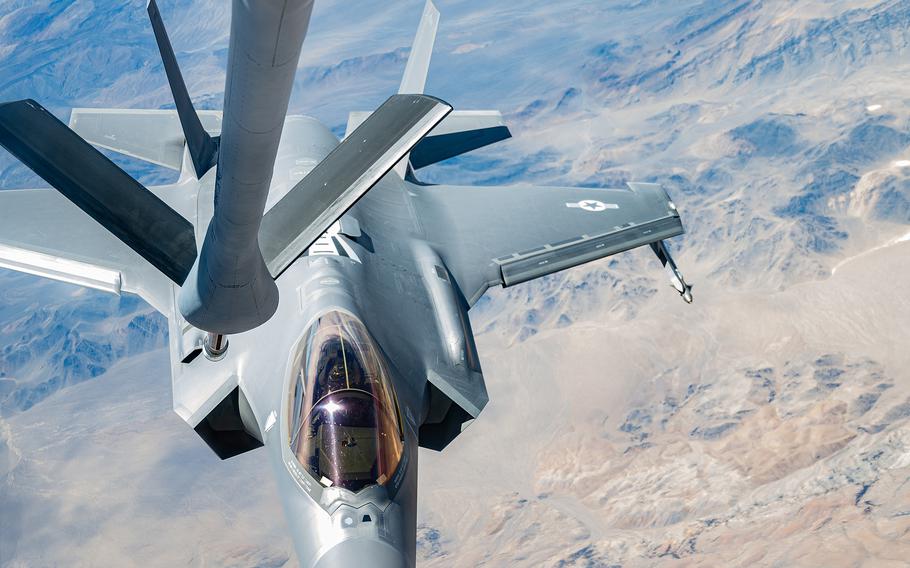
Air Force Tech. Sgt. Nathaniel Small, of the 113th Wing, makes final checks on an F-16 Fighting Falcon before a Red Flag 23-3 training mission at Nellis Air Force Base on July 19, 2023. (William R. Lewis/U.S. Air Force)
One of the U.S. Air Force’s largest combat training exercises this summer focused on an expanded battlefield to prepare for threats posed by China and North Korea, a training officer said recently.
Approximately 2,000 airmen and 50 aircraft from the Air Force, Marine Corps and Navy took to the skies over Nevada, Utah, California and the Pacific Ocean for Red Flag 23-3 between July 17 and Aug. 4, Col. Eric Winterbottom, commander of the 414th Combat Training Squadron, said by phone Aug. 3.
The exercise was designed to increase pilot survivability by exposing them to simulated air-to-air and air-to-ground combat using jets, bombers, drones and electronic attack aircraft, an Air Force statement said.
“For years we’ve operated from relatively secure safe havens and efficiency dictates that we operate from relatively large main operating bases,” Winterbottom said. “It’s important that we transition to more of a distributed model, to spread out and counter the threats that might be out there.”
Red Flag started at Nellis Air Force Base, Nev., in 1975 after Air Force brass realized pilot survivability in Vietnam increased dramatically after 10 combat missions, Winterbottom said.
The exercise typically takes place three times a year, in winter, spring and summer, Nellis spokeswoman Lucretia Cunningham said by email Saturday. One iteration involves Five Eyes participants, an alliance of the U.S. U.K., Canada, New Zealand and Australia; another is U.S. only and the third involves an expanded roster of international allies and partners.
Red Flag 23-3, training for U.S. aircrews only, aligns with the Defense Department’s 2022 National Defense Strategy that identified China as the U.S. military’s No. 1 global “pacing challenge,” the Air Force statement said.

An F-35A Lightning II approaches the refueling probe of a KC-135 Stratotanker during Red Flag 23-3 at Nellis Air Force Base, Nev., on July 26, 2023. (Elizabeth Tan/U.S. Air Force)
The communist nation – with its rapidly expanding and modernizing military – has become increasingly aggressive in the Indo-Pacific region in recent years, militarizing man-made islands, attempting to prohibit freedom of navigation and pressing into disputed territories in the East and South China Seas.
This summer’s Red Flag bridged airspace between the Nevada Test and Training Range, the Utah Test and Training Range and the R-2508 Complex in California to allow for longer range offensive and defensive operations, Cunningham said.
Aircraft - including the F-35 Lightning II, F-16 Fighting Falcon, EA-18G Growler electronic attack, HH-60 Pave Hawk helicopter, KC-135 refueler and MQ-9 Reaper drone – came from as far away as Marine Corps Air Station Cherry Point, N.C., and Naval Air Station Whidbey Island, Wash.
The units are split into “red” and “blue” teams, with F-16s and F-35s from the Nellis-based 64th and 65th Aggressor Squadrons, augmented by visiting F-22 Raptors, F/A-18 Hornets, and B-1 bombers, making up the oppositional force, Winterbottom said. The aircraft participated in dogfights, attacked ground targets and were forced to deal with surface-to-air missile threats, while refueling in a contested environment.
The “red” force mimicked Chinese weapons and tactics, he said.
The Chinese operate fighters, bombers, electronic aircraft and unmanned aerial drones, to name a few. Their domestically produced Chengdu J-20 stealth fighter compares to the Lightning and Raptor, Voice of America reported in April last year, citing Asian security experts.
A portion of the exercise also took place off the Southern California coast, in conjunction with U.S. Navy surface vessels, Cunningham added.
burke.matt@stripes.com Twitter: @MatthewMBurke1